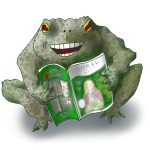
We continue our series of articles in Jèrriais – Jersey’s own traditional native language. The ‘frouque’ in question is a digging fork, rather than a table fork. An English translation follows. This contribution comes from Pat Small.
LES PAPILLOTTES EN JÈRRI
En Êté, s’i’ fait bieau temps, ch’est là qué j’viyons les papillotes voltigeant dans nos gardîns, les pars et dans la campangne. Bein seux, i’ y’en a un tas, des breunes et des blianches, à êt’ veues quand i’ fait du bieau solé et si la tempéthatuthe est caude.
Tchiques papillotes sont visibl’yes partout, mais d’ autres préféthent un envithonnement partitchulyi. Tchitch’eunes volent euniquement au R’nouvé, d’ autres arrivent en Êté du continnent d’ l’Ûrope. Deux’-trais hivèrnent ichîn et ch’t’année i’ y’ avait d’s’êcarlates à volanté. Ch’est possibl’ye qu’i’ y’en a tchi hivèrnent achteu en Jèrri, pa’ce qué nos hivièrs sont pus cauds. Comme nous, il’ ont touos lus préféthences.
Dé temps en temps, tchitch’un dêcouvre eune rareté, ou eune papillote qué les natuthalistes pensaient qu’ou’ ‘tait extîncte en Jèrri. En 2022, auprès tant d’années, eune “Miroir” ‘tait veue, et ch’tait hardi excitant pouor nos entomologistes.
Comme touos l’s însectes, i’ sont îndicatifs des changements d’ l’envithonnement, lé clyînmat et l’s habitats. Même en Êté, i’ n’ volent pon si l’ temps est trop fraid, mucre ou s’i’ y’a du vent. Et, s’i’ n’y’ a pon les correctes pliantes pouor lus carpéleuses à mangi ou à fourni du nectar ès adultes, i’ n’ survivront pon.
Don, en 2004, deux d’ nos bein connues natuthalistes, Margaret Long et Joan Banks, décidîtent à monter un plian pouor monniter et èrcorder les papillotes en Jèrri, et chenna continnue aniet. Ch’est organnisé par Lé Départément d’ l’Envithonnement pouor lé Gouvèrnément d’Jèrri, pa’ce qué les données annuelles sont hardi împortantes pouor l’s èrcords dé l’Ȋle, dé l’ Angliétèrre et d’l’Ûrope étout.
Ch’est eune entreprînse scientifique, l’île est divisée en 34 sections tchi r’présentent toutes les difféthentes sortes d’ habitats ichîn, tels qué la côte, les mielles, les landes, les bouais’sies et la tèrre agritchultuthée.
Au mais d’ Mar, lé pèrsonnel du Départément organnisent un jour d’ensîngn’gnie et des discours entouor les papillotes pouor touos les volantaithes.
Et pis, eune fais châque semaine entre les mais d’Avri et d’Octobre, et d’pis 10 heuthes lé matîn jusqu’à 4 heuthes l’arlevée, un volantaithe compte et èrcorde les papillotes dans san pathage. Il èrcorde la date et l’s heuthes du c’menchement et d’la finnithie, la tempéthatuthe, la vitesse et la direction du vent et lé pouorchentage du solé. Et pis, i’ marche sus la londgeu d’la section, tréjous dans la même direction, en notant toutes les papillotes tch’i’ vait alentou d’ li. Et s’i’ y’ a des changements ou des d’gâts à l’entouothage i’ notifiétha l’ Départément.
À là fîn d’Octobre ses rêsultats sont env’yés au Départément d’ l’Envithonnement d’Jèrri et pis au co-ordinnateu des données en Angliétèrre.
Ch’est comme chenna qu’ nos papillotes nouos donnent eune compathaison des changements d’l’envithonnement – pouor lé bein ou l’ma – année auprés année.
English translation:
BUTTERFLIES IN JERSEY
If the weather’s fine in summer, that’s when we see butterflies fluttering in our gardens, parks and in the countryside. There are certainly a great many brown or white ones to be seen when it’s sunny and the temperature is warm.
Some butterflies can be seen everywhere, but others prefer a particular environment. Some only fly in Spring, others arrive in the summer from the continent of Europe. Two or three hibernate here and this year we have seen an abundance of Red Admirals. It’s possible that they hibernate in Jersey nowadays, because our winters are warmer. Like us, they all have their preferences.
From time to time, someone discovers a rarity, or a butterfly that naturalists thought was extinct in Jersey. In 2022, after many years, a “Miroir” was seen and it was very exciting for our entomologists.
Like all insects they are indicative of changes to the environment, the climate and habitats. Even in summer, they don’t fly if the weather is too cold, wet or windy. And, if there aren’t the correct plants for their caterpillars to eat or to provide nectar to the adults, they will not survive.
So, in 2004, two of our well-known naturalists, Margaret Long and Joan Banks, decided to set up a scheme to monitor and record butterflies in Jersey, and that continues to this day. It is organised by the Department of the Environment for the Government of Jersey, because the annual statistics are very important for the island’s records and also for those of England and Europe.
It is a scientific undertaking. The island is divided into 34 sections which represent all the different kinds of habitat here, such as coast, dune, heath, woodland and agricultural land.
In March, the Department’s staff organise a day of instruction and talks about butterflies for all the volunteers.
And then, once each week between April and October, and between 10 in the morning and 4 in the afternoon, a volunteer counts and records the butterflies in his area. He records the date and the start and finishing times, the temperature, the speed and direction of the wind and the percentage of sun. Then he walks the length of the section, always in the same direction, counting how many of each species of butterfly he sees around him. And if there are any changes or damage to the surroundings he will notify the Department.
At the end of October, his results are sent to the Department of the Environment in Jersey and then to the co-ordinator of the statistics in England.
That’s how our butterflies help us to compare environmental changes – for good or bad – from year to year.




